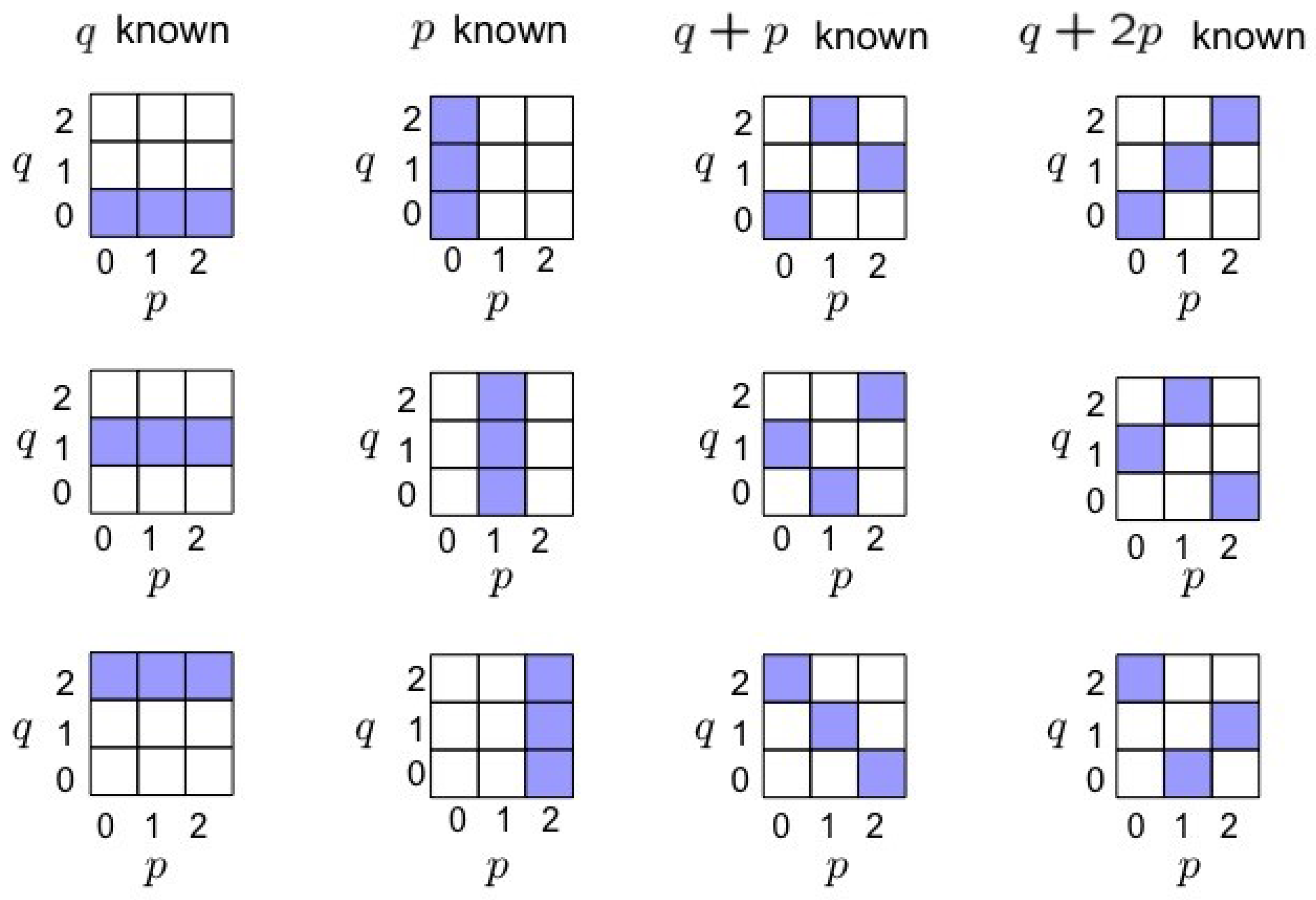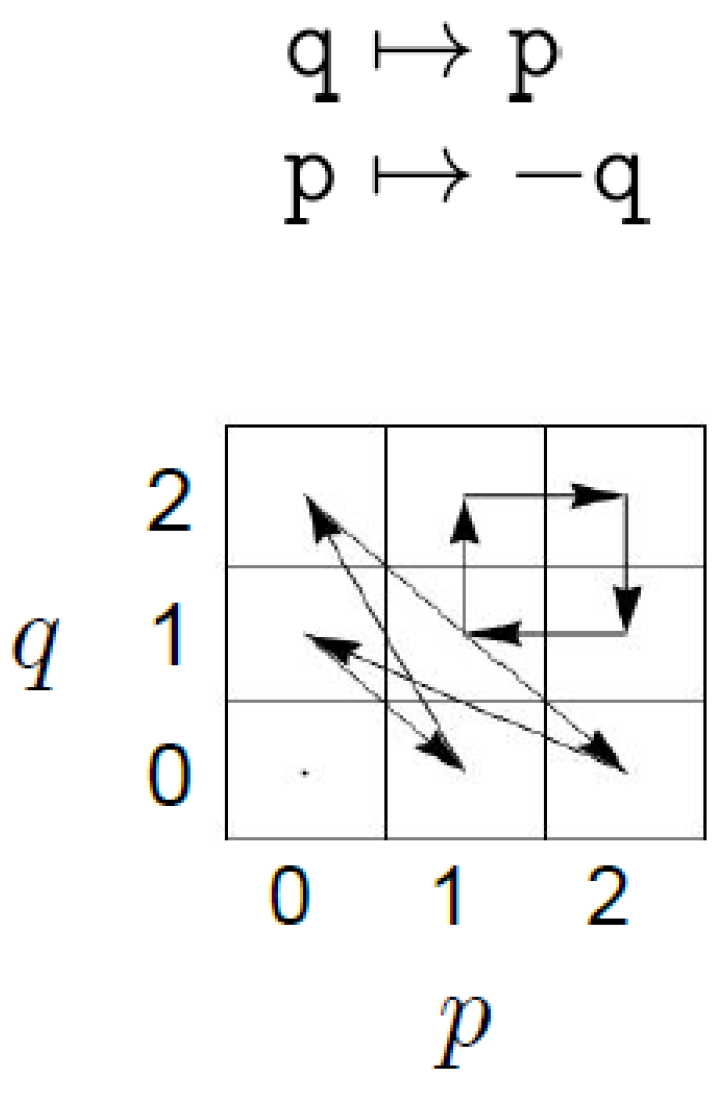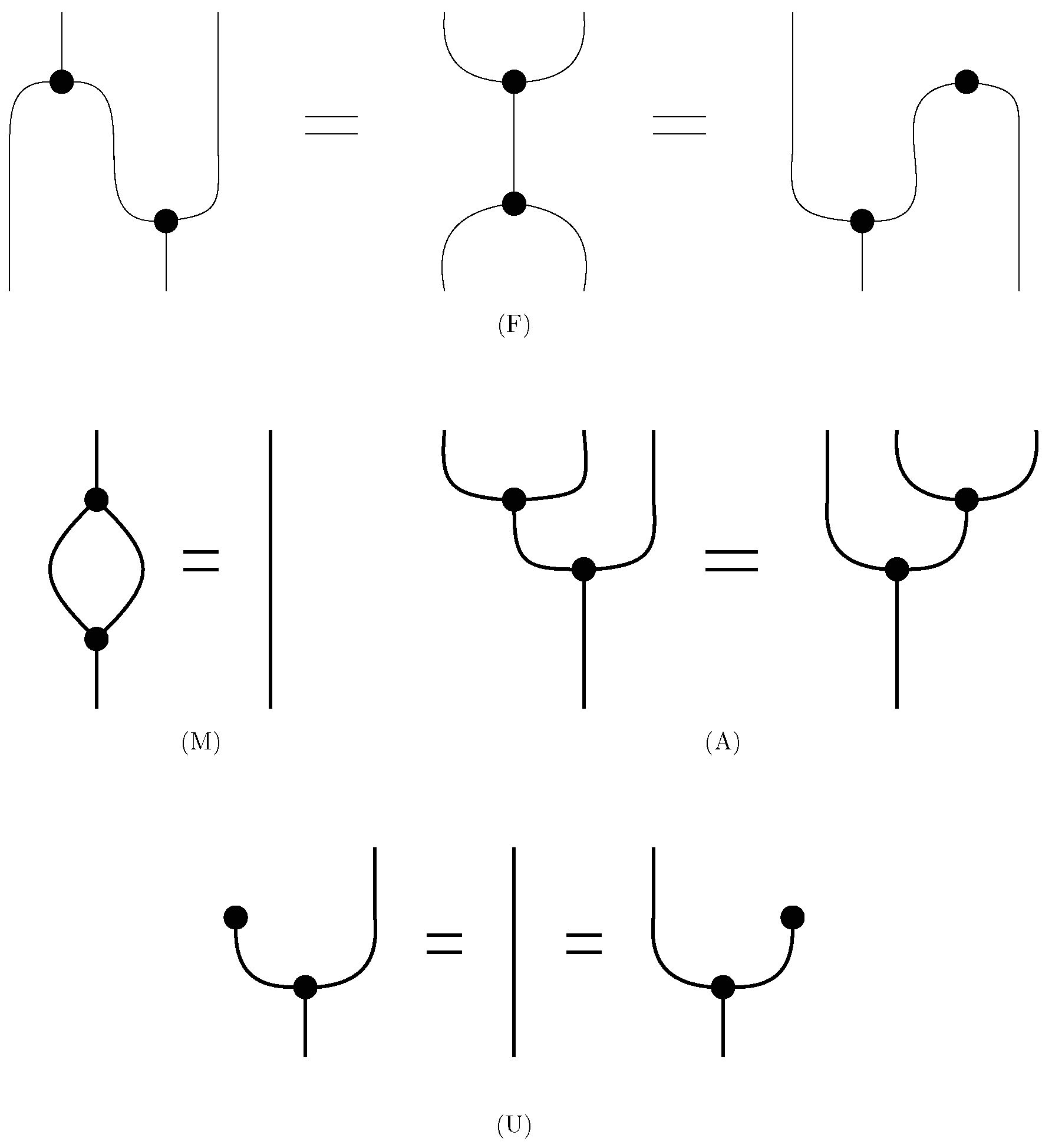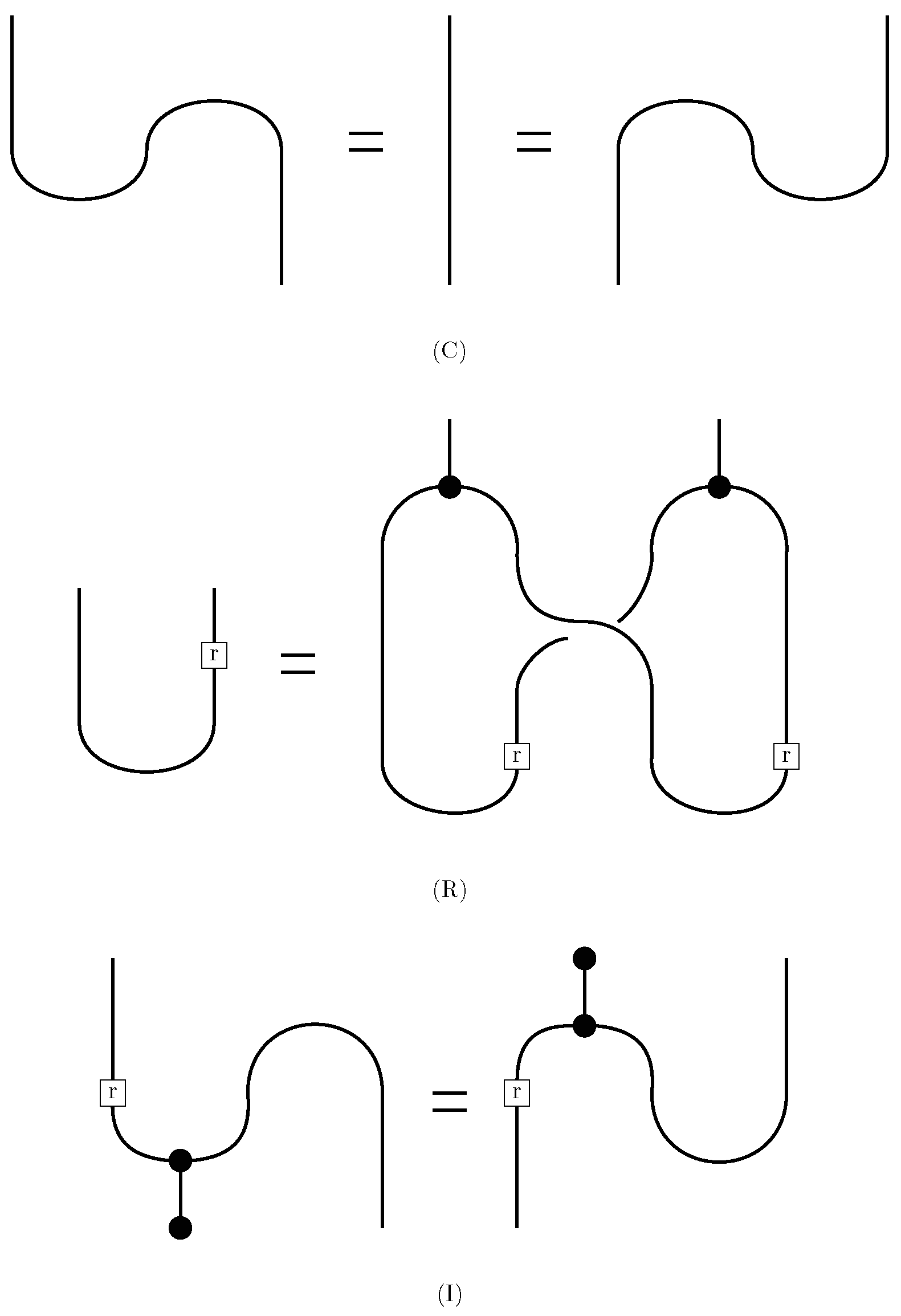1. Introduction
The aim of geometric quantization is to construct, using the geometry of the classical system, a Hilbert space and a set of operators on that Hilbert space that give the quantum mechanical analogue of the classical mechanical system modeled by a symplectic manifold [
1,
2,
3]. Starting with a symplectic space
M corresponding to the classical phase space, the square integrable functions over
M is the first Hilbert space in the construction, called the prequantum Hilbert space. In this case, the classical observables are mapped to the operators on this Hilbert space, and the Poisson bracket is mapped to the commutator. The desired quantum Hilbert space consists of the sections of the prequantum Hilbert space, which depends on the “position” variables. These “position” variables are obtained by splitting the phase space via the polarization
P, which is the Lagrangian subspace (i.e., the maximal subspace where the symplectic form vanishes) of the phase space.
The space of functions on
M is a commutative algebra under the operations of pointwise addition and multiplication. A bivector field on
M determines a Poisson bracket so that
M can be regarded as an approximation to a noncommutative algebra. The quantization approach due to Rieffel aims to obtain such a
-algebra, which is approximated by the Poisson algebra of the functions on
M [
4]. In this case, the algebra after quantization is a continuous field of
-algebras rather than a single algebra. On the other hand, Hawkins suggests a quantization recipe using symplectic groupoids to obtain a single
-algebra [
5]. In this paper, we use the quantization formulation of Hawkins to investigate the epistemic toy theory due to Spekkens [
6,
7].
Recently, there has been a growing interest in quantum foundations in light of the quantum information revolution [
8,
9,
10]. In this direction, Spekkens introduced this toy theory in support of the epistemic view of quantum mechanics [
6]. The toy theory reproduces a large part of quantum theory by positing restrictions on the knowledge of an observer. The distinctively quantum phenomena arising in the toy theory include complementarity, no-cloning, no-broadcasting, teleportation, entanglement, Choi–Jamiolkowski isomorphism, Naimark extension, etc. On the other hand, the phenomena, such as Bell inequality violations, non-contextuality inequality violations and computational speed-up, do not arise in the toy theory.
The toy theory that we are interested in is the generalization of the original theory to the continuous and finite variables [
7]. This is achieved by positing a restriction on what kind of statistical distributions over the space of physical states can be prepared. The new theory is called epistricted theory. In this way, quantum subtheories, the Gaussian subtheory of quantum mechanics, the stabilizer subtheory for qutrits and the Gaussian epistricted optics can be obtained from statistical classical theories, Liouville mechanics, statistical theory of trits and statistical optics, respectively.
The epistemic restriction defined on the classical phase-space states that an agent knows the values of a set of variables that commute relative to the Poisson bracket and maximally ignorant otherwise. Hence, a symplectic structure, which appears in the function space of the phase space, has mathematical correspondence with the ingredients of the quantization scheme. As a result, we conclude that the geometric quantization, via Hawkins’ symplectic groupoid approach, produces a -algebra that encodes the algebraic structure of the quadrature subtheories. Moreover, this construction gives us a functor from epistricted theories to the quantum subtheories.
In the second part of this paper, we construct a similar quantization functor of the toy theory for discrete degrees of freedom. In this case, the toy theory is defined precisely the same as the continuous case except that the finite dimensional symplectic vector space is over a finite field with odd prime characteristic. However, in order to apply groupoid quantization, we resort to the methods of categorical quantum mechanics pioneered by Abramsky and Coecke [
11]. The categorical description of the toy theory is given in [
12,
13,
14], where the toy theory is formulated as a subcategory of the dagger compact symmetric monoidal category of finite sets a
Rel, and the toy observables correspond to dagger Frobenius algebras.
We start our construction with the dagger Frobenius algebras of the toy observables, which are functorially characterized as groupoids by Heunen, Catteneo and the first author in [
15]. After equipping the resulting groupoid with a symplectic structure, we construct the pair groupoid to apply the quantization recipe of Hawkins. One can also obtain this pair groupoid from a different direction called
-construction introduced in [
16]. In the category of Hilbert spaces, Frobenius algebras correspond to finite dimensional
-algebras under this construction as as consequence of [
17]. For the category
Rel, the pair groupoids are the objects of
. Hence, our main result establishes a functor from the dagger Frobenius algebra in
Rel for epistricted theories to the Frobenius algebra in the category of Hilbert spaces.
The outline of this paper is as follows. We begin
Section 2 with a brief summary of the geometric quantization procedure. We then discuss epistricted theories of continuous variables and their correspondence in the geometric quantization framework. We next briefly review Eli Hawkins’ groupoid quantization recipe from which we obtain the usual Moyal quantization as a twisted group
-algebra from the geometric formulation of epistricted theories. We finally conclude that the resulting
-algebra contains phase-space formalism for quadrature subtheories. In
Section 3, we follow the same quantization procedure for the odd-discrete degrees of freedom. We end the paper with the conclusion and discussions.
3. Finite Degrees of Freedom
We now discuss how the geometric quantization relates the epistricted theories to quadrature quantum subtheories for odd-prime discrete degrees of freedom. In [
7], the operational equivalence of these two theories for continuous and odd-prime discrete cases was proven using Wigner representation. Here, we aim to construct a functor from a subcategory of the category of groupoids to the category of
-algebras. This corresponds to a functor from Frobenius algebras in the category
FRel (Frobenius algebras in the category of sets and relations) to Frobenius algebras in the category of Hilbert spaces
FHilb. Here is the sketch of our discrete quantization:
We start with the special dagger Frobenius algebra of epistricted theories, Spek, which is a subcategory of finite sets and relations, FRel.
We then construct the groupoid
corresponding to
Spek via the explicit equivalence in Heunen et al. [
15].
We next obtain the pair groupoid from and introduce the symplectic structure on it, which is compatible with the pair groupoid structure. In this case, each polarization corresponds to a Lagrangian subspace in epistricted theories.
We then apply the geometric quantization procedure via Hawkins on the pair groupoid.
Finally, we end up with the finite dimensional
-algebra from which one can construct special dagger Frobenius algebra over
FHilb via [
17].
We begin this section by reviewing the epistricted theories in the discrete case.
3.1. Quadrature Epistricted Theories
The formalism in the finite case is defined over the finite fields with prime order
d. These fields are isomorphic to the integers modulo
d, denoted by
. Hence, the configuration space and associated phase-space are
,
, respectively. The linear functionals are also in the form:
where
. Hence, a vector
specifies the position and momentum dependence of the quadrature functional
f. The dual space
consists of these vectors associated with the functionals. The Poisson bracket, unlike the continuous case, is defined in terms of finite differences:
Definition 10. The Poisson bracket in the finite case is given by:where the operations are in modulo d. The Poisson bracket, , is also equal to symplectic inner product on the discrete phase space. Like in the continuous case, an epistemic state is determined by the set of quadrature variables that are known to that agent and the values of these variables. This corresponds to the pair , where is an isotropic subspace of the phase space , and is a valuation vector in . Similarly, the valid transformations are symplectic transformations, which preserve the symplectic inner product, and they form the affine symplectic group over the finite field . Note that these transformations over a finite field are discrete in time; hence, they cannot be generated from a Hamiltonian unlike the continuous case.
Example 4. As an example, we consider the quadrature epistricted theory of trits [7] for a single system. The configuration space and the phase space are and , respectively. The quadrature functionals in this system are of the form where , , . There are four inequivalent quadrature functionals:Since none of these functionals Poisson commute, an agent can know at most one of them. This implies that there are twelve epistemic states, as the valuation vectors are chosen from . These states are depicted in Figure 1 as grids: The valid transformations, which form the affine symplectic group over , correspond to a certain subset of permutations of the functionals (See Figure 2 for an example). 3.2. The Category of Epistricted Theories
We now turn to the category of the epistricted theory of trits. The arguments can easily be generalized to the epistricted theories for other odd primes. We start with the category of FRel, whose objects are sets and whose morphisms are relations and . FRel is a dagger symmetric monoidal category when the tensor product is chosen as a Cartesian product, the single element set as the identity and the relational converse as the dagger morphism †.
Definition 11. An object X in FRel with a morphism is called special dagger Frobenius algebra if and only if m has the following properties:
(F)
(M)
(A)
there is with (U).
The conditions of Frobenius algebras are presented graphically in
Figure 3. These diagrams encode composition by drawing morphisms on top of each other, and the monoidal product is the drawing morphism next to each. The dagger is a vertical reflection.
The category FRel has morphisms satisfying:
Proposition 3 ([
15]).
FRel is a compact closed category. Remark 1. Frobenius algebras with some additional properties on the category of finite dimensional Hilbert spaces FHilb correspond to quantum observables [20]. They are called classical structures in this category theoretical context. In [21], the graphical formulization of complementarity is given using the string diagrams. This results in complete graphical calculus for stabilizer quantum mechanics [22] and Spekkens’ toy theory [12]. The compact structure can be induced from the Frobenius algebra by
. As a result of the compact structure, we can define transposes of morphism
by
The category of Frobenius algebras in
FRel with the following morphism is a well-defined category (see Proposition 14 of [
15]).
Definition 12. A morphism in the category of Frobenius algebras in FRel is a morphism satisfying:
(R)
(I) where is a natural swap isomorphism.
These morphisms are depicted in
Figure 4Proposition 4. The category Spek for the toy theory of trits is a subcategory of FRel.
Proof. The category Spek for the toy theory of trits is defined as the category whose objects are the single element one and n-fold Cartesian product of the nine-element set . The morphisms of Spek can be constructed by composition, the Cartesian product and the relational converse from the following relations:
The unit (deleting) relation defined by
The relation
defined as:
| 1 | 2 | 3 | | | | | | |
| 3 | 1 | 2 | | | | | | |
| 2 | 3 | 1 | | | | | | |
| | | | 4 | 5 | 6 | | | |
| | | | 6 | 4 | 5 | | | |
| | | | 5 | 6 | 4 | | | |
| | | | | | | 7 | 8 | 9 |
| | | | | | | 9 | 7 | 8 |
| | | | | | | 8 | 9 | 7 |
For example, , , etc.
The permutations that correspond to affine symplectic maps on the phase-space.
The relevant unit, associativity and symmetry natural isomorphisms.
Twelve epistemic states for a single system are given by the following relations:
| q known: , , . |
| p known: , , . |
| known: , , . |
| known: , , . |
It is straightforward to verify that is the special dagger Frobenius algebra. ☐
Remark 2. This structure corresponds to the observable for which q is known. Hence, the relations , , are the copyable (classical) states for this observable. The other observables can be found by composing m with various valid permutations.
3.3. Frobenius Algebras as Groupoids
We start our procedure of the discrete geometric quantization with constructing the groupoid corresponding to the Frobenius algebra
. The groupoid characterization of dagger Frobenius algebras is given in [
15]. We now give the groupoid following [
15].
Definition 13. The following objects and morphisms in Rel obtained from the Frobenius algebra form a groupoid Σ
in the category of sets and functions Set (see Theorem 7 of [15]).
Remark 3. As proven in [15], this assignment is functorial, if we consider morphisms of groupoids to be sub-groupoids. Considering the set as the finite field , one can equip with the symplectic product .
Lemma 1. The graph of the multiplication is a Lagrangian subspace of .
Proof. Equipped with the symplectic product
,
becomes the Lagrangian subspace of
with the basis
where
. ☐
3.4. Weyl Correspondence and Pair Groupoid
In order to apply geometric quantization, we need a notion of differential forms suitable for the symplectic finite vector space. As noticed in [
23], Kahler differentials are the ideal tool in this setting [
24].
We now briefly review the algebraic geometry that we are going to use. Let:
be the algebra of polynomials in two variables over
. The formal derivatives of the these polynomials are evaluated using the same rules for polynomial functions.
The algebra of Kahler differential
is defined as the
-linear combinations of the following terms:
One can also define the vector space of Kahler
j-forms
for which there is also a differential:
The symplectic product
defined in
Section 2 corresponds to the following Kahler
j-form:
which satisfies
. From now on, we will take
for brevity.
We can now define the pair groupoid and polarization necessary for geometric quantization that will give us the Weyl operator in the discrete case. We first define a skew-symmetric invertible map as .
In the discrete geometric quantization procedure for the symplectic space , the groupoid associated with M consists of , where . G is endowed with the multiplication . M embeds in as the diagonal , and s and t are the projections and . In this groupoid, there is exactly one arrow from any object to another.
Starting with the groupoid
G, one can define a symplectomorphism
from
G to the cotangent bundle
as:
It is then clear that such a groupoid is symplectic, and it integrates the symplectic space
.
is explicitly given as:
where
and
.
Now, we consider two real polarizations of
G:
The symplectic potentials that vanish on
F and
P may be taken as:
We then obtain
. Hence, the inner product polarized sections of line bundles is:
where:
can be considered as the integral kernel of the Weyl operator. From Hawkins’ perspective, the corresponding algebra is the twisted group algebra
. As the Weyl operator is the representation of the finite Heisenberg group
H, as shown in [
25],
is isomorphic to the group algebra of
.
Remark 4. Note that we cannot apply the same procedure to the toy bits, i.e., , as the symplectomorphism Φ and other steps of quantization include division by two.
Our main result produces a functorial quantization via symplectic groupoids, in the case of epistricted theories with an odd prime number of degrees of freedom.
Theorem 3 (Main result for the finite case).
The discrete geometric quantization procedure is a functor from the Frobenius algebra in Rel for epistricted theories to the Frobenius algebra for stabilizer quantum mechanics in the odd prime discrete case.
Proof. can be equipped with a symplectic structure so that it becomes the symplectic groupoid where the polarization is
corresponding to
in
. Hence, the quantization gives us a subalgebra of
as we only consider the linear combination of position and momentum operators. The resulting operator algebra is a projective representation of the finite Heisenberg group given by the above discrete Weyl transform
W. The stabilizer states are joint eigenstates of commuting Weyl operators. In [
7], it has been shown that the stabilizer states is equivalent to quadrature states of epistricted theories.
The resulting finite dimensional algebra
is equivalent to a dagger Frobenius algebra in
Hilb (see Theorem 4.7 of [
17]). By the functoriality of quantization in this specific case and the functoriality of the above embedding into
(see Corollary 4.4 of [
16], we obtain a functor from the dagger Frobenius algebras in
Rel to the dagger Frobenius algebras in
Hilb. The affine symplectic transformations of the epistricted theories are mapped to the group representations of the affine symplectic group, which acts as a superoperator in the resulting
-algebra. ☐
We now construct a pair groupoid
M from the dagger Frobenius algebra
. We start with the monoid structure
in
Rel, where
. This monoid is a specific example of endomorphism monoids in [
17], which is an analogue of algebras of bounded linear operators. Note that the new monoid multiplication
is precisely the multiplication in
in the pair groupoid, and the unit is the diagonal
. The abstract polarization
P in this context can be cast as
. We denote this monoid as
The algebra
can be embedded into endomorphism monoid
similar to the fact that every algebra has a homomorphism in the algebra of operators. The embedding homomorphism
is defined by:
It is easy to show that
h preserves multiplication and the unit. One can also refer to Lemma 3.19 in [
17] for a more general case. Let
denote the image of
h in the endomorphism monoid. We now can construct the groupoid
from the dagger Frobenius algebra
following the construction in [
15] one more time:










